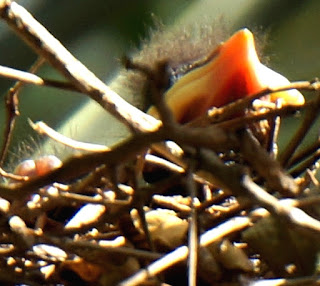 |
| Danielle Fibikar holding a greater bulldog fishing bat at VIERS
|
For example, bees get most of the credit for helping
immobile plants engage in sexual reproduction. During the day we can see bees
busily going from one flower to another. They drink the sweet nectar and at the
same time carry pollen on their hairy legs from male stamens to female pistils.
But many flowers on St. John only open at night. This is
because they have evolved to attract bats instead of bees – especially Jamaican
fruit bats and Antillean cave bats. Unlike bees, the bats accomplish their
match-making missions under the cover of darkness.
Night-blooming flowers attract bats by offering them nectar
that smells deliciously like fermented fruit. These flowers also have to be
large enough for bats to squeeze into and pick up pollen while lapping up the
tasty nectar. Just like the bees, bats carry pollen on their bodies and deliver
the precious powder from flower to flower. However, they can cover longer
distances on their night missions and make contact with female flowers far
away. This provides widely scattered trees with greater access to genetic
diversity and helps them enjoy enhanced reproductive success.
In the Virgin Islands, mangoes, bananas, guavas, cashews,
calabash, century plants and kapok trees all depend on bats for pollination.
Fruit-eating bats also help the trees and plants expand
their territory by dropping their seeds in different parts of the island.
Besides the Jamaican fruit bats and Antillean cave bats, there are also more
specialized red fig-eating bats. These are quite elusive, but one night
Danielle observed five of them near the Reef Bay petroglyphs, apparently lured
by a fruiting fig tree.
Other bats – including the velvety free-tailed bat – prefer
to hunt down insects, especially the mosquitoes that come out at dusk. Like a
miniature air force they protect us from bugs that bite. According to a study
by the Island Resources Foundation, a single bat can consume as many as 500
insects in just one hour or nearly 3,000 insects every night.
www.irf.org/documents/VI_Bat_C%20&_M_Plan_December%2009.pdf
Unfortunately, these bats aren’t a big help in getting rid
of the Aedes mosquitoes that carry the Zika virus (as well as dengue and
chikungunya), because those mosquitoes are mostly active during the day.
Danielle’s favorites are the greater bulldog bats (Noctilio
leporinus), which zoom along the Lameshur Bay road just after dark, using it as
a corridor from their daytime roost (a hollow tree or cave) to their offshore
fishing areas. With a wingspan of up to almost two feet, these are the biggest
bats found on St. John. Like James Bond, the famous fictional member of the
British secret service, the males attract not one but a whole harem of
available females, exuding a musky perfume that enhances their sexual allure.
 |
| Measuring a bat's wing |
Danielle has been studying St. John bats for several years
as a graduate student under the guidance of Dr. Richard Veit from the College
of Staten Island. She first came to VIERS for a short college course on
Tropical Ecology, and fell in love with the bats. She has just received her
Master’s Degree in Biology, and has written a thesis on the Ecology and
Epidemiology of Bats in Temperate and Tropical Islands, which presents some of
her work at VIERS on documenting bat population numbers during different seasons.
With the assistance of her colleague Pearl Cates, Danielle
will conduct additional research at VIERS this summer – while also teaching
campers about bats and sharing her enthusiasm for them. Recognizing that not
everyone loves bats (yet), she hopes to counter some of the spooky ideas about
them by emphasizing their intelligence and ecological services, as well as
their musky magnetism.
Her main research activity involves setting up lightweight
‘mist’ nets across the Lameshur road to trap bats as they swoop by. One night
in January 2015, Danielle caught members of all five of the types of bats
commonly found on St. John. When she gets one in the net, she disentangles it
(wearing thick yellow gloves) and weighs and photographs it. Then she puts a small
band on it – unless it already has one. She has recaptured a number of
previously banded bats, which indicates that there is a relatively small
community of bats near VIERS, and that they tend to stay in the neighborhood.
The VIERS Eco-Camp is supported by the Friends of the
National Park and other generous sponsors. It offers an opportunity for more
than 100 local students to learn about the wildlife of the Virgin Islands (not
just bats), as well as training for some not-so-secret eco-protection missions
of their own.
 |
| Danielle weighing a bat |






































